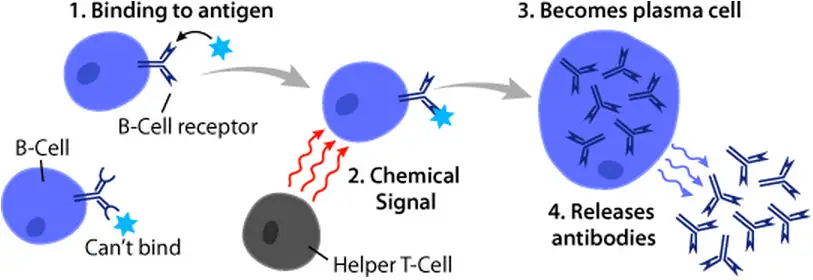[ad_1]
B-Cell Development Stages

CD34 is a general cell surface marker on the pluripotent hematopoietic stem cell.
When the common lymphoid progenitor receives survival signals from IL-7R binding, then the progenitor cell commits to becoming a B-cell phenotype.
IL-7R signal –> leads to commitment to B-cell
Early pro-B cell: D-J rearrangement (for heavy chain)
Late pro-B cell: V-DJ rearrangement (for heavy chain)
Large pre-B cell: mu heavy chain is made (for Ig) [1st checkpoint – selecting for functional heavy chains]
Small pre-B cell: V-J rearrangement (for light chain)
stem cell –> early pro-B cell –> late pro-B cell –> large pre-B cell –> [1st checkpoint – selects for functional heavy chains] –> small pre-B cell –> [2nd checkpoint – select for functional light chains] –> Immature B cell (has surface IgM, no surface IgD)
precursor B cell (pre-B) has cytoplasmic u mu

Somatic recombination is the process in which different individual gene segments of the H (heavy) chain combine with rearranged gene segments of the L (light) chain.
Light chain genes are located where? Light chain genes include both the Kappa genes and Lambda genes. Kappa genes are located on Chromosome 2. Lambda genes are located on Chromosome 22. Remember that the light chain expressed of the final immunoglobulin or B-cell/T-cell receptor is either the Lambda or Kappa.
Kappa Light chain genes = located on Chromosome 2
Lambda Light chain genes = located on Chromosome 22
All Heavy H Chain genes = located on Chromosome 14
Somatic recombination is enzyme-mediated.

The enzymes responsible for somatic recombination are the recombinase enzymes (RAG-1 and RAG-2) that recognize specific sequences (RSS) or recombination signal sequences. RAG-1 and RAG-2 are only expressed in B or T lymphocytes. These specific sequences recognized by the RAG-1 or RAG-2 enzymes are either a 1) heptamer or 2) nonamer. The heptamer literally contains 7 nucleotides, and the nonamer literally contains 9 nucleotides. There are typically 12 or 23 nucleotides in between the heptamer and nonamer to separate them.
The 12/23 rule: Only 12 nucleotide-spaced RSS can combine with a 23-spaced nucleotide RSS. Forms a coding joint, and the signal joint (or intervening DNA sequence) is then removed.
7-12-9 or 7-23-9 RSS sequences for Recombinase enzymes RAG-1 and RAG-2
There are 2 somatic recombination events for the Heavy chain. First, D-J are combined together. Second, V-DJ are combined together.
There is only 1 somatic recombination event for the Light chain, bringing V-J segments together. Remember, the light chain does not contain D gene segments at all.
Junctional Diversity: addition of P and N nucleotides during gene rearrangement
P stands for Palindromic nucleotides, these are deleted and then N nucleotides are added by the enzyme TdT.
Productive Rearrangement vs Nonproductive rearrangement
Early pro-B cell –> Late pro-B cell
(H chain) –> (H chain rearrangement) (has a temporary surrogate light chain)
Productive rearrangement means signaled to survive and move onto the next stage.
Nonproductive rearrangement tells the cell the gene rearrangement wasn’t successful or and tells the cell to do another gene arrangement. If the second trial of nonproductive rearrangement doesn’t work for the Late pro-B cell, then 50% of the cells are signaled to die by apoptosis.

Pre-b cell (light chain gene rearrangement)
- Rearrange Kappa gene on first chromosome
- Fails –> Rearrange Kappa gene on 2nd chromosome
- Fails –> Rearrange Lambda gene on 1st chromosome
- Fails –> Rearrange Lambda gene on 2nd chromosome
- Fails –> Apoptosis
Activation induced cytidine deaminase AID enzyme responsible for somatic hypermutation of the V region sequences, specifically the complementarity determining regions (CDR) of the V region sequences.
AID enzyme = responsible for Somatic Hypermutation (targeted CDR light chain Variable region) and Isotype switching (targeted cytosines in switch regions for constant heavy chain region)
Important Immunology Enzymes
RAG-1 and Rag-2 = Somatic Recombination
TdT Enzyme = Junctional Diversity = Addition of P and N nucleotides
AID enzyme = Somatic Hypermutation = Note that somatic hypermutation is not somatic recombination. Somatic hypermutation occurs after the B cell receptor encountered an antigen, and the B cell now wants to improve or refine their variable region to better fit the same antigen in the future.

Click and check out these popular articles for more information: 🙂
Ectoderm vs Endoderm vs Mesoderm
Psychology 101 and the Brain: Stress – Definition, Symptoms, and Health Effects of the Fight-or-Flight Response
Circulatory System: Blood Flow Pathway Through the Heart
Circulatory System: Heart Structures and Functions
Ductus Arteriosus Vs Ductus Venosus Vs Foramen Ovale: Fetal Heart Circulation
Cardiac Arrhythmias: Definition, Types, Symptoms, and Prevention
Upper Vs Lower Respiratory System: Upper vs Lower Respiratory Tract Infections
Seven General Functions of the Respiratory System
Digestive System Anatomy: Diagram, Organs, Structures, and Functions
Kidney Embryology & Development: Easy Lesson
Psychology 101: Crowd Psychology and The Theory of Gustave Le Bon
Introduction to Evolution: Charles Darwin and Alfred Russel Wallace
Symbolism of Shoes in Dreams
Immunology 101: Innate vs Adaptive Immunity

Thank you for visiting, and we hope you find our free content helpful! Our site is run 100% by volunteers from around the world. Please help support us by buying us a warm cup of coffee! Many thanks to the kind and generous supporters and donors for doing so! 🙂
Copyright © 2022 Moosmosis Organization: All Rights Reserved
All rights reserved. This essay or any portion thereof may not be reproduced or used in any manner whatsoever
without the express written permission of the publisher.

[ad_2]
Source link





More Stories
It’s Time to Embrace the Emotional or Affective Turn
How to Improve Employee Productivity
Administrative Advocacy with Laurie Chang and TpT School Access